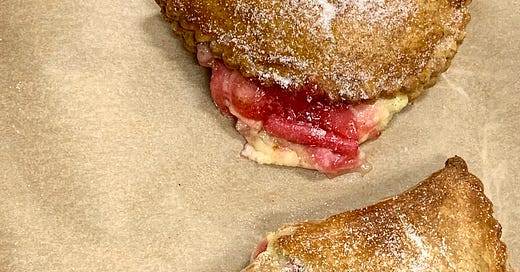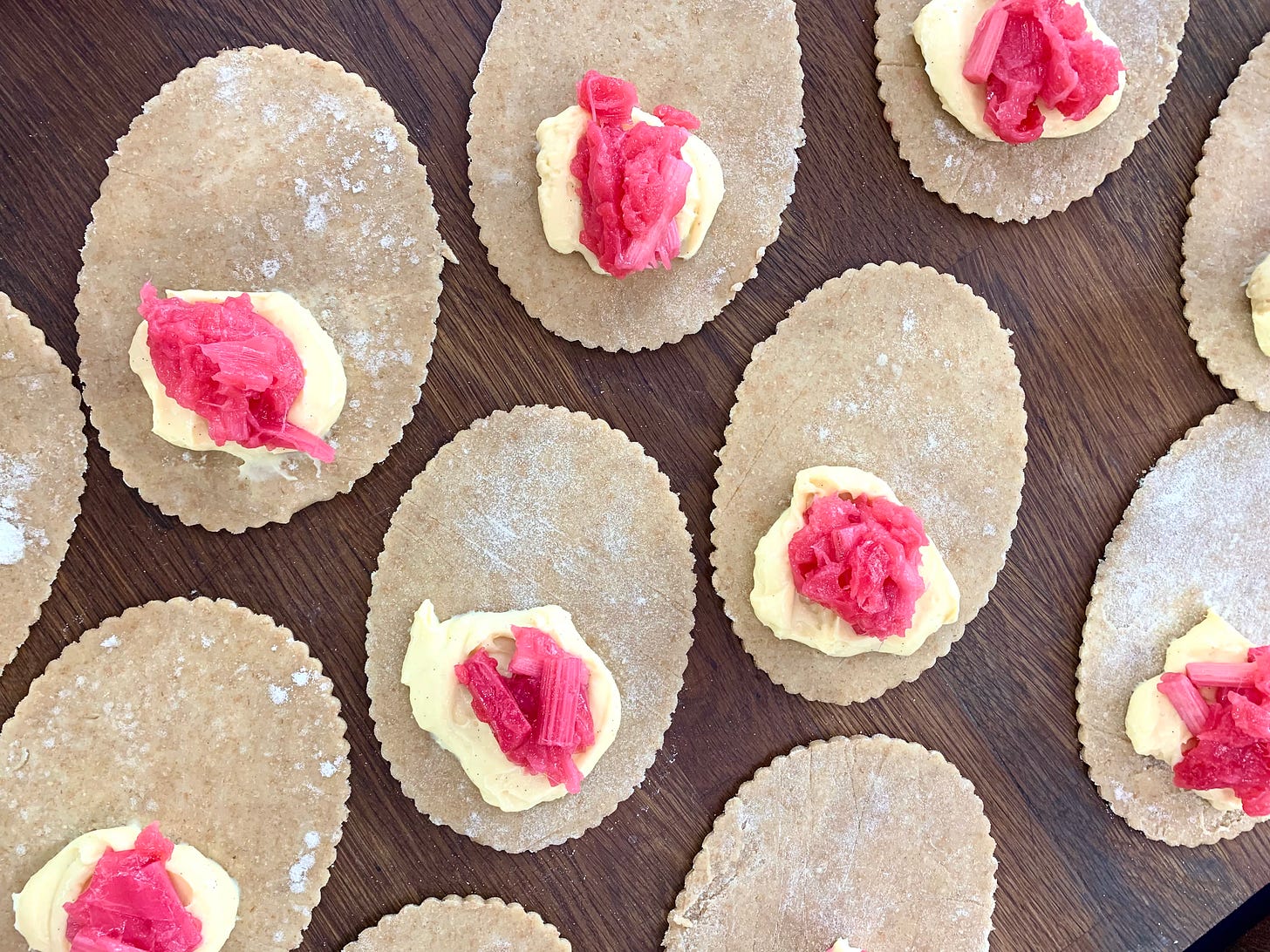Rhubarb has arrived! The bright pink petioles born of the dark are so welcome, able to lift the spirits on the coldest days, inspiring and reviving your baking mojo. There really is nothing like it.
For a deep dive into forced rhubarb cultivation in my neck of the woods, take a look at this newsletter, where you can find the recipe for the rhubarb and custard pie that is always a must-make project at this time of year.
Rhubarb and custard are one of the all-time great pairings, think bread and butter, salt and pepper, Fred and Ginger. The undeniably magic duo summon a flavour profile that evokes a taste memory as strong as Proust’s tea and Madeleines. The pie is perfect if you’re feeding a crowd, but if pocket-sized pastry is more your thing, I recommend these turnovers.
You can create everything there is to love about the pie in a more personable portion using the recipes below. I’ve adapted the original rhubarb filling, reducing the thickener as the filling remains contained this time. As far as the custard is concerned, we need one that is thick and sturdy enough to assemble the turnovers yet stable enough to undergo another bake without sacrificing the final texture; we don’t want it to scramble or split inside the pastry.
Finally, we need a trusty and reliable pastry to encase the filling. This is where you can do you and choose shortcrust, flaky, rough puff, full or invert puff, whichever you prefer to eat or make. The choice is yours. Subscribers to the ‘Extra Credit’ portion of the newsletter will find details on the 1:1:2 pastry that makes for a fuss-free, tender, and flaky pastry; it comes together in minutes and works a charm for these turnovers.
Once you have all three components assembled, it’s a cutout and assemble job, and again, you can use your creativity to form the turnovers into any shape you wish. I use a Chausson cutter to portion the dough; its rough dimensions are 16.5cm x 12cm, creating the size I’m looking for. Use the quantities below as a guide when making these, and adjust the recommended amounts of filling according to the size or turnover you decide to make.
Vanilla Custard
(30g used per turnover)
160g whole milk
90g double cream
seeds from half a vanilla pod
60g egg yolk
40g caster sugar (divided 20g+20g)
20g flour
pinch fine sea salt
Follow the classic creme patissiere method. Heat the whole milk, double cream, vanilla and 20g caster sugar in a saucepan. Ensure the sugar dissolves and the mixture comes up to a bare simmer.
Mix the remaining 20g caster sugar with the flour and add the egg yolks; whisk together immediately until smooth. Add the warm dairy to the yolk mix in a steady stream, whisking to incorporate and form a smooth custard base.
Return this mixture to the saucepan and heat, stirring until it starts to thicken, then switch to a whisk and beat the mixture as it thickens, ensuring that it stays lump-free. Allow it to bellow and bubble for 1-2 minutes, indicating that the starch has fully cooked out.
Remove from the heat, pour into a bowl or container and press parchment or film to the surface. Allow to cool fully before using to assemble the turnovers. This can be made ahead of time and keeps for up to three days in the fridge.
Rhubarb Filling
(30g used per turnover)
200g rhubarb (cut into inch-long sticks)
splash of water
40g caster sugar
12g cornflour
pinch fine sea salt
Place the prepared rhubarb in a saucepan with a splash of water and heat on low to medium until the sticks begin to sizzle and soften, approximately 5 minutes or until they release juice. Mix the sugar, cornflour and pinch of salt together and add to the rhubarb; mix well to coat each stick.
Continue to cook, and within a few minutes, the rhubarb will have softened more, and the juices will have started to thicken. The mixture will be a cloudy pink colour, but as you continue to cook it for a further 5 minutes, you will see the colour change from opaque to translucent and glossy.
Remove from the heat and allow to cool completely before assembling the turnovers. This can also be made ahead of time and like the custard, will keep for up to three days in the fridge.
Notes on assembly -
The turnovers can be assembled and frozen to be baked to order whenever you want. Brush with eggwash or double cream before baking, cut a vent to allow steam to escape and bake in an oven preheated to 200 degrees; reduce the temperature to 175 degrees C as soon as you put them in and bake for 20-25 minutes until golden brown on the top and bottom.
Upon their exit from the oven, dust them with fine caster sugar and finely grated nutmeg.
At the bakery, we have the luxury of working with beautiful ingredients, ones we choose for their quality, provenance and impact, whether environmental or social. But of course, it goes without saying they come at a cost, so we’re resourceful and savvy about how we use them. Back pocket ratios and formulas that you can repeat over and over again become the saving grace in ensuring nothing goes to waste.
This pastry is based on such a ratio, a formula that I call on week in and week out. It’s dependable, quick to come together, forgiving and versatile. It stems from the need to find a use for double cream (which comes in multiples of 2 litres from our milk man) and ensures that no drop goes to waste. A bakery would not be a bakery without a supply of double cream, and should supplies run low, I’d be on edge. Even more so, should I have litres of good quality organic cream about to go past its best and be wasted. Thankfully, I have the 1:1:2 pastry in my back pocket.





